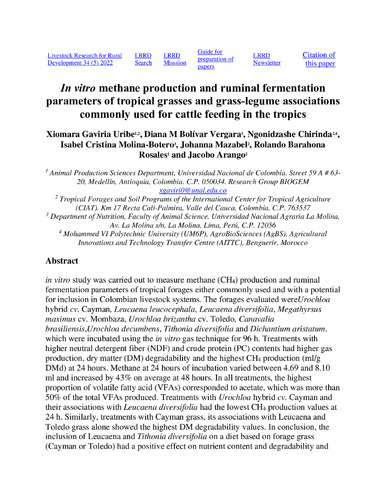In vitro methane production and ruminal fermentation parameters of tropical grasses and grass-legume associations commonly used for cattle feeding in the tropics
In vitro study was carried out to measure methane (CH4) production and ruminal fermentation parameters of tropical forages either commonly used and with a potential for inclusion in Colombian livestock systems. The forages evaluated wereUrochloa hybrid cv. Cayman, Leucaena leucocephala, Leucaena diversifolia, Megathyrsus maximus cv. Mombaza, Urochloa brizantha cv. Toledo, Canavalia brasiliensis,Urochloa decumbens, Tithonia diversifolia and Dichantium aristatum. which were incubated using the in vitro gas technique for 96 h. Treatments with higher neutral detergent fiber (NDF) and crude protein (PC) contents had higher gas production, dry matter (DM) degradability and the highest CH4 production (ml/g DMd) at 24 hours. Methane at 24 hours of incubation varied between 4.69 and 8.10 ml and increased by 43% on average at 48 hours. In all treatments, the highest proportion of volatile fatty acid (VFAs) corresponded to acetate, which was more than 50% of the total VFAs produced. Treatments with Urochloa hybrid cv. Cayman and their associations with Leucaena diversifolia had the lowest CH4 production values at 24 h. Similarly, treatments with Cayman grass, its associations with Leucaena and Toledo grass alone showed the highest DM degradability values. In conclusion, the inclusion of Leucaena and Tithonia diversifolia on a diet based on forage grass (Cayman or Toledo) had a positive effect on nutrient content and degradability and the group of treatments that included Cayman grass and its associations had lower CH4 production values and higher degradability than the rest of the treatments.

